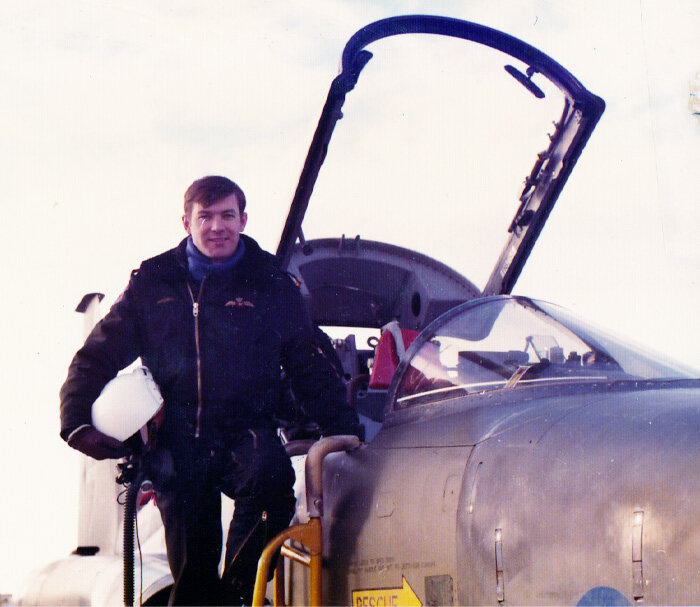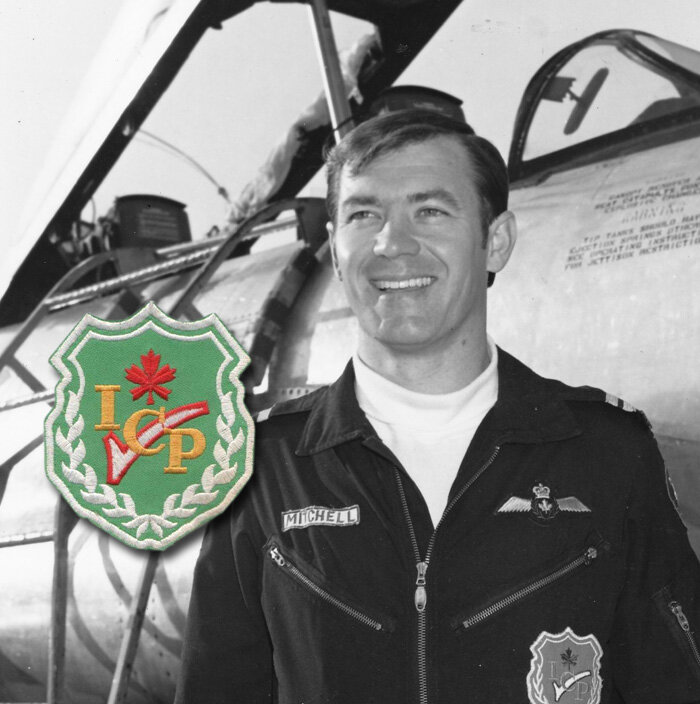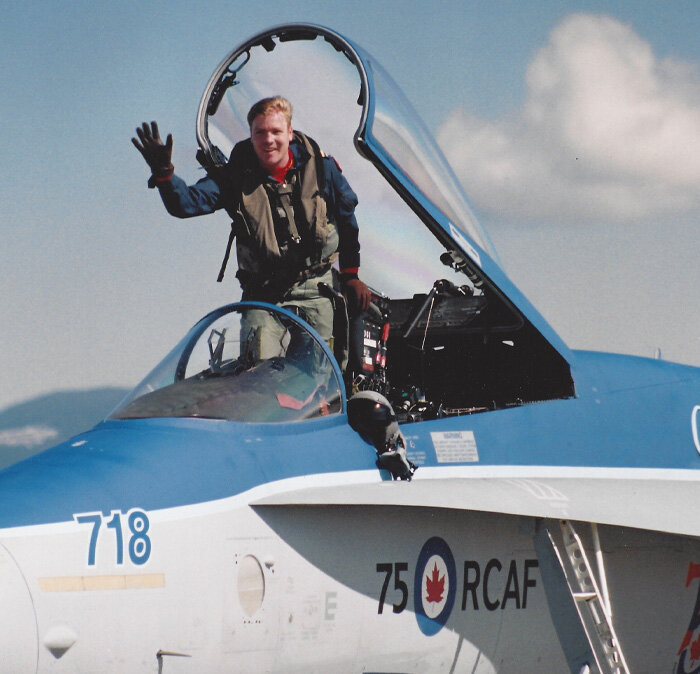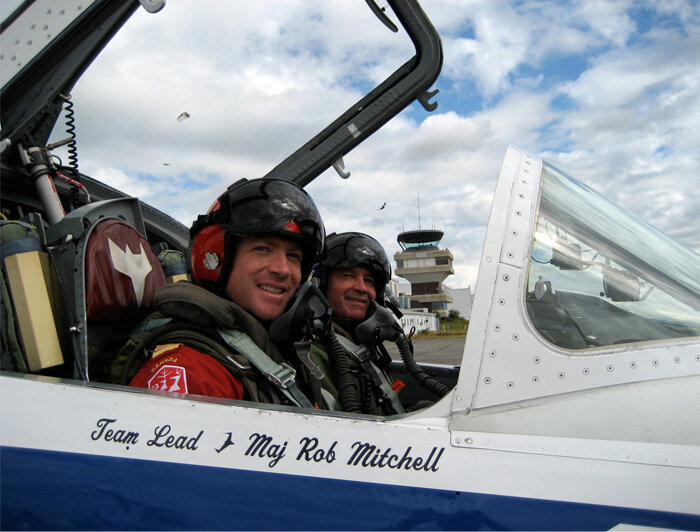AND THEN THERE WERE TWO
Back in 1991, working at Ottawa’s National Capital Air Show, I welcomed a young Rockwell B-1B bomber pilot as he stepped down from the ladder of his “Bone” after the long flight from Ellsworth Air Force Base in South Dakota. The Bone was call sign TIGER 11 from the 32nd Bomb Squadron of the 28th Bomb Wing. The pilot dropped his flight and helmet bags to the hot tarmac, stretched his back, pulled a ball cap from the lower leg pocket of his speed-jeans, put it on and then reached into his left shoulder pocket, pulled out a velcro-backed “Fun Meter” patch which showed the fun level pinned in the red zone and slapped it on his shoulder. Then he reached out his hand, and with a wide flashing smile said, “Now I am ready, ...name’s Captain Tibbets, Captain Paul Tibbets”.
As I pumped his hand, I held out a cold beer, which he first rubbed against his forehead. Then as his head tilted back for a long draw on the ice cold can of beer, I read his USAF name tag: “Paul ‘Nuke’ Tibbets IV”. “Really?” I asked, “You really the great grandson of Paul Tibbets?” “Nope.” he said, “I’m his grandson... he was Paul Tibbets Jr.” I felt guilty about smiling at the black humour of his call sign “Nuke”, but somehow honoured to be shaking the hand of the great grandson of Enola Gay herself. I said to him, gushingly, “Imagine that... three generations of bomber pilots in the same family.” He flashed a central casting smile and said, “Nah, actually, my father, Paul Tibbets III, was a pharmacist.”*
Since that day, I have always wondered if there were other examples of multi-generational air force families. Surely the exploits of a Spitfire or Lancaster pilot from the Second World War would, as they did all us baby boomers, inspire the sons of the same heroes of the war to take to the air in the same roles as their fathers. And following that, it was indeed possible that their grandsons or today, even their granddaughters, had followed the same inspirational path to the skies as military flyers of the same ilk.
In 1999, one such family got together in Cold Lake, Alberta and, with a couple of 2-seat CF-18 Hornets, flew together in Canadian skies—the Grandfather a Second World War Spitfire Pilot, the Father a Cold War fighter pilot and the Son a post-cold war fighter pilot and jet team aerobatic pilot. Just this past January, Fred Mitchell, that Canadian Spitfire pilot and patriarch of three generations of Canadian fighter pilots, died in his home town of Sudbury, Ontario after a long life of service—to his country as a fighter pilot and to his community as a firefighter.
One of Fred’s greatest accomplishments was his family, and in particular the fighter pilot spirit he was able to foster in his son Bob and in turn in his grandson Rob. When grandson Rob Mitchell won his Canadian Air Force wings, Fred had the honour to travel to Moose Jaw, Saskatchewan to pin his grandson’s wings on him. Then, on that day in 1999 in Cold Lake, he also got to do what I doubt many, if any, have ever done... as a 77 year old man, take to the skies in a fighter aircraft to fly and fight again—with his son and his grandson!
Perhaps the greatest moment in Rob Scratch Mitchell’s exceptional flying career was the day at Cold Lake, Alberta when all three generations took to the skies together in two CF-18 Hornets of 410 Squadron Cougars. Rob flew with his father Bob in the back of one CF-18 two-seater and his Grampa Fred flew with 410 Squadron Commander, LCol Al Stephenson. The mission was a full-on four-ship 2v2 Air Combat Manoeuvring (ACM) training mission for a couple of new instructors in the other two Hornets. Fred Mitchell was in the other 2 ship, so Rob and Bob took a pause mid-mission and Scratch did a 1v1 demonstration of Basic Fighter Manoeuvres (BFM) with his wing man to show his father how CF-18 fighter pilots fight the jet these days. Later in the flight Grampa Fred Mitchell went supersonic for the first time!!! The entire mission lasted 1 hour and ten minutes and ended with a four-ship break overhead Cold lake. Pulling some hard Gs in the break, Second World War Spitfire pilot Fred Mitchell said he felt right at home. Photo via Mitchell Family Collection
Of that remarkable day over the Primrose Range, north of Cold Lake, grandson Rob Mitchell recalls: “What a great flight. Grampa was initially nervous but once they took off, he was back in the saddle. I could see him wander in thought often later that day - no doubt contemplating what could have been.” Though Fred Mitchell has passed on, there is no doubt that the lessons he imparted to his son and grandson live on. Rob Mitchell, emotional and creative, tender yet lethal, speaks in the warmest reverential tones when he speaks of the man he called Grampa:
“He was pretty quiet about his time in war,” says the third generation fighter pilot about the patriarch of the warrior dynasty, “but opened up more and more in the last few years. He told me things of great pride, happiness and tragedy. Most moving to me was the occasional reflection back to the young warrior he was - his posture would change, his language and his eyes. Through and through he was a peaceful man, but for fleeting glimpses I could clearly see the fighter pilot warrior.”
The memory of Spitfire pilot Fred Mitchell lives on today... in the name of his great grandson, Freddy Mitchell. One day, he may in fact take his place as the fourth generation Mitchell fighter pilot. Rob Mitchell smiles. “You just never know”, he says.
Here for your enjoyment are a few photos, some from the Mitchell Family albums, following the flying careers of a Canadian family that truly felt the need for speed and answered their country’s call.
First Generation: 421 Squadron Spitfire Pilot Fred Mitchell
Young Leading Aircraftman and flying student Fred Mitchell of Sudbury, Ontario, Canada did his Elementary Flying Training at No.13 EFTS St. Eugène, Ontario, about 100 kilometres east of Ottawa on the broad, flat Ottawa River valley. It was here, in the winter of 1942 and then at No. 2 Service Flying Training School in Ottawa, that he honed his skills as a military pilot. Photo via Flight Ontario
I asked Rob Mitchell the same question as I ask any pilot who got their EFTS training on Fleet Finches at St. Eugène, “Could you look in his logbook and tell me if he had an instructor by the name of Fred Jones? If not Jones, then Scott Smilie?” Fred Jones was my father-in-law at one time and Scott Smilie was an instructor there who had helped teach the late Flight Lieutenant Bob Kirkpatrick of Humboldt, Iowa, one of my dearest friends. Indeed, one of Fred’s instructors was Scott Smilie, as seen in this shot of the early pages in his log. St. Eugène has long since faded away, but the memory of men like Mitchell, Jones, Smilie, Kirkpatrick and all the young men who once lifted to the heavens over this idyllic spot will endure through their children, grandchildren and holy artifacts like their logbooks. Photo by Rob Mitchell
Related Stories
Click on image
After getting his wings at No. 2 Service Flying Training School at Uplands in Ottawa, Mitchell wasted no time getting to England and No. 7 Advanced Flying Unit (AFU) at Peterborough, Cambridgeshire. At this AFU, he got a refresher course in high performance flying on the Miles Master in order to sharpen the flying skills which may have grown rusty during the transit by train to Halifax and the crossing of the Atlantic. The Master, designed and built by Miles Aircraft Ltd. was relatively fast, strong enough to deal with novice fighter pilot skills and was fully aerobatic. It was an excellent introductory aircraft to the high performance British fighter aircraft that Mitchell would eventually fly—the Spitfire. The Master had a unique seating configuration for a trainer. The instructor sat in the back on an elevated seat looking over the head of the student and protected by a windscreen, which he popped up. Seen here is Mile Master DK681, one of the Masters operated by No. 7 AFU at RAF Peterborough. Photo via Larry Button Collection at 1000aircraftphotos.com
Another fine look at the Miles Master in training colours—camouflage over yellow undersides—as it would have looked when Mitchell flew them in the summer of 1943. Photograph via Wikipedia
After getting up to speed on the Miles Master in England, Fred Mitchell was sent to North Africa and No. 73 Operational Training Unit (OTU) at Abu Suier. Abu Suier was originally formed on 20 November 1941, at Sheikh Othman in the seaport city of Aden, Yemen, under the control of No. 207 Group. It would be January 1942 before sufficient personnel were available to begin training. Initially the unit operated a slim selection of Curtiss Mohawks and Hawker Hurricanes and was tasked with training fighter pilots in desert conditions. It then moved to Abu Sueir along the Suez Canal, where it began operating in February 1943 as a fighter-bomber training unit. It came under No. 203 Group on 10 May 1943 and moved to Fayid in June 1944, disbanding there on 25 September 1945. Here we see Spitfire “Trop”, a tropicalized Spitfire Mk V from No. 73 OTU in North Africa, with a special Vokes filter under her chin. It was on this type of Spitfire that Fred Mitchell began his front line fighter training. Photo by Stan Colley, Peter Arnold Collection
A flight of three Spitfire Mk V Trops flying over the Egyptian desert. Roger Andrews at thescale.info explains: “A flight of Spitfire Mk Vs, most likely with 73 OTU in 1944/45. JK926/1 and JG933/6 (the two closest Spitfires) both served with 73 OTU at that time. The aircraft would seem to have been repainted in the day fighter scheme, at a Maintenance unit in the Middle East.” Photo via Derek Pennington at thescale.info
Another 73 OTU Spitfire showing the obviously less streamlined face of the otherwise gorgeous Spitfire V. Photo from Fritz Johl Collection via Tinus le Roux
Spitfire V Trops at 73 Operational Training Unit at Abu Suier, Egypt along the edge of the Suez Canal. Instructor Collin Sinclair of the South African Air Force stands at the wing. Photo from Colin Sinclair Collection
No. 73 Operational Training Unit Spitfire V Trop overhead Abu Suier, Egypt. Photo by Bomb Finney from Colin Sinclair Collection via Tinus le Roux
A pair of 73 OTU Spitfire V Trops roars across the Western Egyptian desert. Photo from Fritz Johl Collection via Tinus le Roux
Another shot of a 73 OTU Spitfire (this one without the Vokes filter) overflying the Great Bitter Lake and the Suez Canal. The Great Bitter Lake is a saltwater lake which is part of the Suez Canal. It is connected to the Small Bitter Lake, through which the canal also runs. Photo from Fritz Johl Collection via Tinus le Roux
Young Spitfire pilot Fred Mitchell leans casually next to a Spitfire Trop somewhere in the North African Desert, likely Abu Suier, Egypt near the Suez Canal. Note the large Vokes filter air scoop under the Trop’s chin. Spitfires in North Africa operated in some extreme conditions with sifting sand, dust and extreme heat. Supermarine Spitfires that were assigned to the Mediterranean and North African theatres of operation had to have modifications made to the air induction system. Two different air filtering systems were used on these Spitfires, which unfortunately altered their famous streamlined good looks. The Aboukir Tropical Filter had a shorter intake scoop, while the Vokes system (above), used for filtering out the omnipresent desert sand, had a longer intake. These North African Vokes Spitfires were also used in Mid East and Far East theatres of operations. Photo via Mitchell Family Archive
After OTU at Abu Suier, Mitchell spent a few months in Sardinia for additional training on Spitfire Vs, VIIIs, and IXs, before being sent back to England to join a Canadian squadron—the RCAF’s 421 Red Indian Squadron, flying Merlin-powered Spitfire IXs and Griffon-powered Spitfires. It was in December of 1944 that the 421 squadron received the Spitfire XIV. In 1945, the unit participated in the liberation of the Netherlands, before moving into Germany. At the end of the war, the unit had achieved over 90 aerial victories. Photo via Mitchell Family Archive
One of the many special connections that Fred Mitchell had with his grand son Rob was that, as a member of the 421 Red Indian Squadron, he flew Spitfire AU-J. Our own Spitfire, SL721, is painted to commemorate a 421 Squadron Spit with that very aircraft code on its sides. It is not known whether the AU-J written into Fred’s logbook on 17 May 1944 was the same Mk XVI that ours is dedicated to, known to have been the personal aircraft of Flight Lieutenant William Harper. Photo by Rob Mitchell
Mitchell flew many Spitfire marks including Mk XIVs and Mk XVIs with 421 Red Indian Squadron, RCAF. One of them, AU-J, seen here, is how our Spitfire Mk XVI is painted and dedicated to Fred’s squadron mate, Flight Lieutenant William Harper, also of Ontario. Photo: RCAF
On 28 July 1945, whilst ferrying an ex-41 Squadron Spitfire Mk XIV (EB-Q MV264) to an advanced landing field in occupied Germany (B.174 Utersen (awaiting confirmation from Mitchell's logbook)), Fred Mitchell was very nearly killed when his aircraft cartwheeled off the runway. This forward airbase runway was made from a flexible steel matting known as Sommerfield Tracking (SMT). Unfortunately some of the SMT had come loose. Upon landing, and rolling out, the Spitfire developed a bow wave of the SMT in front of the tires. At one point the wave pushed back and caught the tires, causing the aircraft to flip over and cartwheel off the track, coming to rest on its back on the infield grass with a crushed and shattered canopy. Photo via Mitchell Family Collection
A close-up of the remains of the 41 Squadron Spitfire in which Fred Mitchell was very nearly killed in Germany. Mitchell recalled thinking “Duck!" and it was lucky indeed that he did. When he came to, hanging from the straps with French turf jammed in his face, he heard the ticking of the magnetos and flipped off the engine switch. The crews arrived and ignored him at first, certain he was dead. It was several minutes later when they heard him and realized that indeed he had survived, relatively intact. Looking at this image, one sees how they had assumed his neck had to have been broken. Photo via Mitchell Family
A dashing young Warrant Officer Fred Mitchell, looking confident, takes a break for a smoke and a coffee. After the end of the Second World War, Mitchell continued to fly, with 411 and 416 Squadrons, in Spitfire XVIs. Photo via Mitchell Family Archive
After his Second World War service as a Spitfire pilot, Fred Mitchell chose a career as a firefighter rather than continue on in the RCAF as he was offered. He spent a lifetime as a member of the Sudbury Fire Department, rising to become Chief. The man in this photo does not look like a man you would want to cross. Photo via Mitchell Family Archive
Second Generation: Captain Robert “Bob” Mitchell, ICP
Fred’s son, Bob Mitchell, was inspired by his father’s experiences in the Second World War and he joined the Canadian Air Force (now once again the RCAF thankfully). He started his flying career as a navigator/weapons officer on CF-101 Voodoos with 416 Lynx Squadron in Chatham, New Brunswick, but he longed to fly like his father. He did a short additional stint as a de Havilland Canada CC-108 Caribou navigator, flying relief supplies into Peru after the June 1970 earthquake, before he cross-trained to the front seat. Bob Mitchell was one of the few pilots who earned their wings on the CF-5 Freedom Fighter. Here we see him and a Freedom Fighter shortly after earning his wings. Photo via Mitchell Family Collection
After earning his wings on the CF-5 Freedom Fighter, Bob Mitchell would go on to instructing other new pilots on the CT-114 Tutor with “The Big 2” (No. 2 Canadian Forces Flying Training School), at Moose Jaw, Saskatchewan from 1975 to 1980. This was followed by two years of T-33 flying with 414 Squadron, the Black Knights. After a long ground tour for advanced education and a staff placement, Bob returned to the air at the Instrument Check Pilot School at Central Flying School (CFS) in Winnipeg. Here he takes the fighter pilot’s knee in front of a CFS Tutor as Raven 14. Photo via Mitchell Family Collection
From 1980 to 1982, second generation fighter pilot Captain Bob Mitchell was an instructor at the Central Flying School in Winnipeg, Manitoba. This school was where flying instructors were trained for duty at Moose Jaw and Portage La Prairie. In 1987, Mitchell returned to Central Flying School as an Instrument Check Pilot (ICP), proud to wear the ICP patch, demonstrating excellence and accomplishment in instrument flying. Bob checked out Canadian pilots’ abilities in instrument flying on the venerable CT-33 Silver Star, or as all Canadians called them, the T-Bird. On the canopy edge of the T-Bird behind him in this photo, we can see the fabric hood which would be closed for instrument training. After 20 years with the Canadian Air Force, he left to take up a flying instructor position with BAE in Saudi Arabia, flying the Pilatus PC-9. For a time, Mitchell was the highest time Pilatus PC-9 pilot in the world. At just 50 years, he retired in 1998 to Whideby Island in Puget Sound. Photo via Mitchell family Collection, Inset J.F. Chalifoux
Third Generation: Lieutenant Colonel Robert “Scratch” Mitchell
Fred Mitchell’s grandson would go on to the most stellar career of all. Young Rob “Scratch” Mitchell, taking a knee in the time-worn fighter pilot style, helmet in hand, in front of his spectacularly painted RCAF 75th Anniversary CF-18 Demo Hornet (s/n 188718). Rob and the Hornet were part of 410 Squadron Cougars, the CF-18 Training unit at 4 Wing, Cold Lake, Alberta. Photo via Rob Mitchell
Here, three of the most versatile and enduring aircraft types in history fly together in an anniversary flight. Leading the flight is the Boeing E-3 Sentry of the North Atlantic Treaty Organization in its 50th Anniversary year paint scheme, featuring the flags of all 19 member nations. Off its big right wing we see Rob Mitchell in the RCAF 75th Anniversary CF-18 and then a CT-33 Silver Star from 414 Black Knights sporting a sinister yet celebratory paint scheme also commemorating the 75th anniversary of the Royal Canadian Air Force. Photo by Mike Reno
Captain Rob “Scratch” Mitchell, the ultimate performer, acknowledges an air show crowd, climbing out of the 410 Squadron CF-18 Hornet Demo bird. His sociable nature and superb performances with the CF-18 in 1999 made him a logical choice for the Canadian Forces Snowbird demonstration team later in his career. Photo via Rob Mitchell
As the CF-18 Demonstration pilot for the Canadian Air Force, Scratch had a bit of pull around the 410 hangar and was able to bring together his father (left) and his grandfather out at Cold Lake for a once-in-a-lifetime event—the three generations of Canadian fighter pilots flying together. This was at the time of the 1999 Cold Lake Air Show and Canadian Space Agency astronaut, Julie Payette, was on hand to meet the family. Photo via Mitchell Family Collection
Earlier in his career, Scratch Mitchell did a two-year tour with the Snowbirds and came back in 2006 as the team lead. Photo via Rob Mitchell
Any military pilot will tell you that they would love the chance to show their parents what they have accomplished. Rob Mitchell got to do than more than once. As Snowbird Lead in 2007, he had the opportunity to take his retired fighter pilot dad up with him in Snowbird 1 as he led the team in a practice. Photo via Rob Mitchell
Rob and his father in Snowbird 1 shine identical smiles before taking off for some team aerobatics. Photo via Rob Mitchell
Scratch has been flying jets pretty well all of his adult life. Upon retirement from the RCAF as a Lieutenant Colonel, Rob went to Canada’s WestJet Airlines as a 737 First Officer. Though still technically flying jets, he was definitely not flying them upside down. Rob joined Vintage Wings as our Safety Officer for a couple of years then came on board as one of the Hawk One F-86 Sabre demonstration pilots. Here we see him in the cockpit and getting “in the zone” at the Abbotsford International Air Show in 2011. Photo by Peter Handley
I had the good fortune to fly beside Rob Mitchell’s Hawk One F-86, in an aircraft of his grandfather’s vintage. Vintage Wings pilot Paul Kissmann in the P-40 (with the author in the back) leads Rob Mitchell in the Hawk One Sabre and the CF-18 Demo Hornet at the Kitchener–Waterloo Air Show in 2011. After the Second World War, Fred Mitchell had an offer to return to the RCAF and fly jets like the F-86, but decided to stay with the Sudbury, Ontario Fire Department instead. He had always wondered what it would have been like to fly the F-86 and his grandson was able to sit down with him and share his perspective and his knowledge of the Sabre. Photo by Andy Cline
Lieutenant Colonel (Wing Commander) Rob Scratch Mitchell at British Columbia’s Abbotsford International Air Show in 2011. Years of being a show pilot gave Scratch a certain comfort in front and behind the camera. Photo: Peter Handley
Scratch Mitchell, now a civilian, hasn’t missed a beat in the world of air demonstration. Now he is part of the Patriots Jet Team out of Byron, California, where he flies the nimble L-39 Albatros as No. 5, the outer left wing position. The Patriots Jet Team allows Rob to exercise one of his two passions in life—aerobatic team flying. Rob flew for WestJet Airlines for a few years after retiring, but reluctantly gave that up to pursue a lifelong dream to be involved in the film business, both as an actor and a film producer. Photo via Patriot Jet Team website
The Patriots Jet Team is a civilian aerobatic formation team that performs in air shows across the western United States of America. The Patriots currently operate as a six-ship team, flying the Czech-built Aero L-39 Albatros. The Patriots are based in Byron, California. Photo via aerobaticteams.net
Scratch and Grampa. Rob Mitchell received his passion for flight from his father who had it passed down to him with his DNA from Fred Mitchell, Canadian Spitfire pilot. Fred Mitchell died on 18 January 2014 at the age of 92, fighter pilot to the end. Photo via Mitchell Family Collection







































